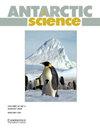The nightlife of a Ross seal: diving and haul-out behaviour from the eastern Weddell Sea
IF 2
4区 地球科学
Q3 ENVIRONMENTAL SCIENCES
引用次数: 0
Abstract
Abstract Ross seals (Ommatophoca rossii) travel away from the pack ice and spend most of their year foraging pelagically. Here, we augment the few existing records of Ross seal diving and haul-out behaviour, providing novel insights into how these are influenced diurnally and seasonally. We used biologging devices that recorded the dive behaviour (n = 5) and/or haul-out behaviour (n = 9) of Ross seals in the eastern Weddell Sea (2016–2019). Ross seals mostly dived between 100 and 200 m deep, often > 300 m, and for 5–12 min in duration, often > 20 min. During March–July, when Ross seals forage pelagically, diving metrics varied diurnally. The seals dived deeper during twilight and shallowest at night, while the number of dives and diving duration did not follow a clear diurnal pattern. Consequently, diving effort was highest during the night. Ross seals preferentially hauled out in the middle of the day during September, October, February and December, but not during the rest of the year. Three females that entered the pack ice during breeding season were hauled out continuously for 5–7 days, punctuated by water entries for 1–3 h during and/or after such continuous haul-outs over the breeding season. This behaviour might suggest that Ross seals alternate between capital and facultative income breeding.罗斯海豹的夜生活:来自威德尔海东部的潜水和拖运行为
摘要罗斯海豹(Ommatophoca rossii)远离浮冰,一年中大部分时间都在群岛上觅食。在这里,我们补充了罗斯海豹潜水和拖运行为的少数现有记录,为这些行为如何受到昼夜和季节性影响提供了新的见解。我们使用生物记录设备记录了威德尔海东部罗斯海豹的潜水行为(n=5)和/或拖离行为(n=9)(2016-2019)。罗斯海豹大多潜水深度在100至200米之间,通常>300米,持续时间为5至12分钟,通常>20分钟。在3月至7月,当罗斯海豹在群岛上觅食时,潜水指标在白天变化很大。海豹在黄昏时潜水更深,在夜间潜水最浅,而潜水次数和潜水持续时间没有遵循明确的昼夜模式。因此,夜间的潜水努力最高。罗斯海豹优先在9月、10月、2月和12月的中午被拖出来,但在一年中的其余时间不被拖出来。在繁殖季节进入浮冰的三只雌性被连续拖出5-7天,在繁殖季节连续拖出期间和/或之后,不时进水1-3小时。这种行为可能表明罗斯海豹在资本和兼性收入繁殖之间交替。
本文章由计算机程序翻译,如有差异,请以英文原文为准。
求助全文
约1分钟内获得全文
求助全文
来源期刊

Antarctic Science
地学-地球科学综合
CiteScore
3.60
自引率
6.20%
发文量
42
审稿时长
3 months
期刊介绍:
Antarctic Science provides a truly international forum for the broad spread of studies that increasingly characterise scientific research in the Antarctic. Whilst emphasising interdisciplinary work, the journal publishes papers from environmental management to biodiversity, from volcanoes to icebergs, and from oceanography to the upper atmosphere. No other journal covers such a wide range of Antarctic scientific studies. The journal attracts papers from all countries currently undertaking Antarctic research. It publishes both review and data papers with no limits on length, two-page short notes on technical developments and recent discoveries, and book reviews. These, together with an editorial discussing broader aspects of science, provide a rich and varied mixture of items to interest researchers in all areas of science. There are no page charges, or charges for colour, to authors publishing in the Journal. One issue each year is normally devoted to a specific theme or papers from a major meeting.
 求助内容:
求助内容: 应助结果提醒方式:
应助结果提醒方式:


